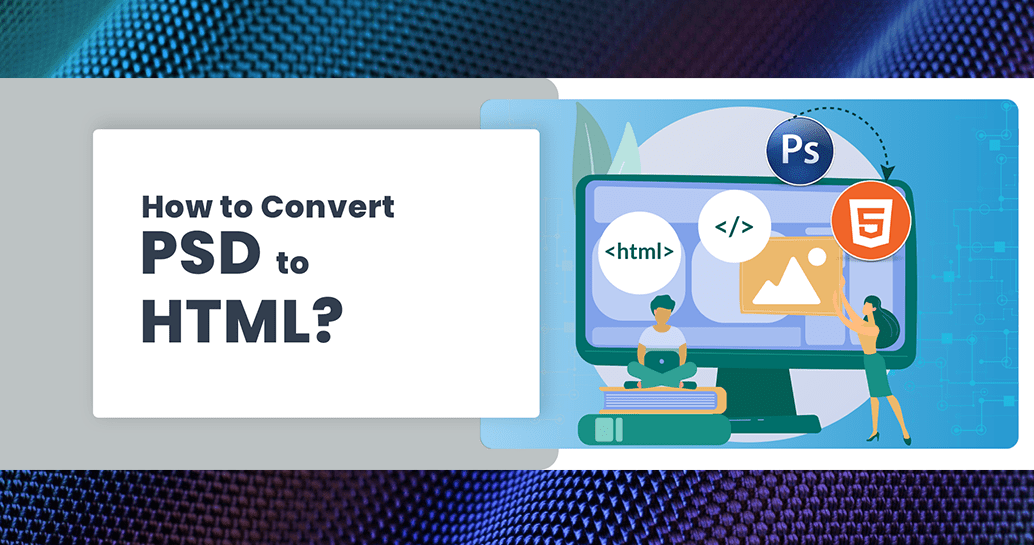
How to Convert PSD into HTML?
![]() Taru M.
Taru M.
Published: 11 Jan, 2021
MoreoverIn today’s technological advancement era, everything becomes simple and quick. However, the process of web designing is not an exception. Website designers of let grab opportunities to avail of numerous techniques to design a website – conversion of Photoshop design into a website- is popularly known as PSD to HTML conversion.
Before we discuss the several steps of PSD to HTML conversion, let’s dive into the basics to grab things in-depth.
Table of Contents
1. About PSD?
2. About HTML?
3. Guide to Convert PSD to HTML
-
- Slice PSD Design
- Directory Creation
- HTML Pages
- Style Files
- Web Design Set
- Use JavaScript
- Make Design Responsive
1. About PSD?
Well, PSD is nothing but a short form of Photoshop, which doesn’t need any specific introduction as it is already the most powerful image editing software. Be it creating the design or editing images, PSD brings possibilities for everything. Web designers prefer to make a design file in PSD format first before converting it into HTML.

2. About HTML?
HyperText Markup Language is popularly known as HTML in a short form. As a popular coding language, developers leverage HTML for creating a variety of websites. It is also known for having an excellent capability of making perfect use of preset tags. Developers must get familiar with these tags before starting the PSD conversion process to HTML.

3. Guide to convert PSD to HTML
The conversion process of PSD to HTML involves multiple steps. Let’s discuss here all these steps that professional designers go through to create a final design.
Slice PSD Design
Designers initiate the conversion process by slicing the PSD file into multiple pieces while ensuring every detail has various layers. The actual reason to do this is to quickly make the page load as a single design file takes much time to download.
While slicing design files, professionals get different slicing options: standard, fixed aspect ratio, slice from guides, or fixed size. Use the ‘Save for the Web’ option to save your sliced files. Designers keep the sliced design in the related directory.
Directory Creation
The next step that professionals go through is directory creation. They create the necessary directory for managing their data conveniently and also in an organized way. One needs to complete these required directories.
– Create a main folder either with your website’s name or the name that you will not face difficulty in recognizing the later stage.
– Professionals create a folder within the main folder and name it ‘Images.’ They use this folder to store all your images.
– Create a folder within the main folder for style sheets or CSS file and name it as ‘Styles.’
HTML Pages
Now professionals proceed to create HTML pages from top to bottom. Be it Amaya, Dreamweaver, or Komposer; one can use any of these options for creating HTML pages. Designers create a new file in Dreamweaver software and then save it as index.html in the main folder.
Style Files
Now professionals create a style file that provides an HTML page for all necessary information related to features such as background colour, font size, image position, fieldset, etc.
However, to create the file in Dreamweaver, they save a new file in the CSS folder as styles.css.
Your CSS style sheet needs to link with the HTML page with the use of a link tag.
Moreover, make sure you enter the page name. It’s necessary to provide an appropriate link in the ‘href’ tag. Now it’s time for professionals to work with the style sheet by defining the wrapper and the Class.
Web Design Set
It’s now time to create a design set by putting multiple elements together.
Therefore, for this, professionals leverage the Dreamweaver. They make a quick layout with the use of HTML with CSS for getting an impeccable foundation. After this, they set everything, be it images or background color, while ensuring all essential elements are in a good position.
Use JavaScript
So, after completing all the above steps, professionals leverage the power of JavaScript frameworks like jQuery, vue.js, AngularJS, and react.js.
However, JQuery serves as a library that can organize the DOM and includes some great functionality to help designers create dynamic and impeccable layouts.
Another reason to use these JavaScript frameworks is to make the coding front-end job relatively easier and smooth.
Make Design Responsive
Professionals use CSS media queries and several other frameworks such as Fluid Baseline Grid, Twitter Bootstrap, and others to make the design responsive.
They also do customization work for every targeted screen for personalizing output for every screen. Moreover, it ensures the powerful presence of your website on different platforms.
Copyright © 2023 NetMaxims Technologies Pvt. Ltd.
All Rights Reserved














